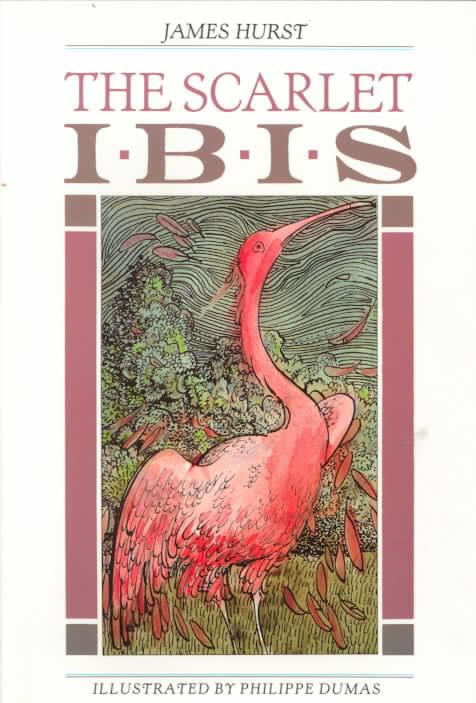Originally published July 1960 Country United States of America | Published in The Atlantic Monthly Publication date July 1960 | |
 | ||
Similar The Most Dangerous Game, The Cask of Amontillado, The Gift of the Magi, The Rocking‑Horse Winner, I Know Why the Caged Bi | ||
The scarlet ibis part one of three
"The Scarlet Ibis" is a short story written by novelist James Hurst. It was first published in The Atlantic Monthly in July 1960 and won the "Atlantic First" award. It has become a classic of American literature. It has been frequently republished in school textbooks and other collections.
Contents
- The scarlet ibis part one of three
- short story the scarlet ibis part 1
- Plot
- Analysis
- Opera
- James Hurst
- References
short story the scarlet ibis part 1
Plot
The Narrator, who is not named but simply called "Brother", recounts the life of his younger brother, William Armstrong, nicknamed "Doodle". Doodle is born a sickly child who is not expected to live because of his birth defects. His family even has a small coffin made in the case of his death. Doodle survives, but for most of his babyhood, he is unable to move or respond to his environment. Brother even goes so far as planning to smother the baby with a pillow, thinking that having no brother was better than having a brother who wasn't truly there. Luckily, Doodle smiles at Brother before he can do the deed, and, overjoyed, Brother leaves him be.
Doodle eventually learns to crawl, even though the doctor says the strain of even sitting up might kill him because of his weak heart. He crawls backwards, though, reminding the narrator of a doodlebug, leading him to nickname William, "Doodle". But Doodle is still very weak and feeble. Doodle's brother wanted someone who could run and jump and play with him, but resents having the weak and fragile Doodle instead. The narrator even has to pull his brother around in a wooden go-cart his father built him, because Doodle can't walk. It is now that Brother decides to train Doodle to be a "normal human being". He takes Doodle down to the swamp to teach him how to walk.
Eventually, shortly before his sixth birthday, Doodle learns to walk with help from Brother. Encouraged by this, Brother decides to teach Doodle how to run, climb vines, swim, row and even fight to prepare Doodle for school. However, almost a year after the plan was made, Doodle was far from accomplishing the goals by the nearing deadline.
One day, a big red bird appears in their garden, looking sick and tired. The boys' father identifies it as a scarlet ibis, a tropical bird that was blown off-course by a recent storm. When the bird dies, Doodle, pitying the creature, buries it, while the rest of the family looks on and laughs. Afterwards, the boys go to the nearby Horsehead Landing to continue Doodle's "training". On their way back to the house, Brother has Doodle practice rowing. A sudden rainstorm comes, and when they reach the riverbank, Doodle is tired and frightened. Brother, angry and frustrated that Doodle could not finish his training before school starts, runs ahead of Doodle, leaving the frightened boy behind. When Brother does not see Doodle, he returns for him, his anger dissipated. To his horror, he finds Doodle, lifeless, lying on the ground with blood flowing out of his mouth, staining his throat and shirt a brilliant red. Doodle died like the scarlet ibis: bloody red and far away from home.
Analysis
The story has been described as "rich in symbolism." The Scarlet Ibis is the main symbol in the story, as is the color red and the ibis in comparison to "Doodle" as fragile yet majestic. The storm is often compared to Doodle's brother because the brother pushed him too hard, much as the storm did with the scarlet ibis. The story also examines the ambiguous nature of pride: "I did not know then that pride is a wonderful, terrible thing, a seed that bears two vines, life and death."
Opera
The story was developed into an opera by composer Stefan Weisman with librettist David Cote. The opera was co-produced by New York City's Beth Morrison Projects and HERE Arts Center in association with American Opera Projects, and premiered in the PROTOTYPE Opera Festival on January 8, 2015. New York Times critic, David Allen, called the opera "a moving, intense and dignified creation."
James Hurst
James Hurst was born January 1st, 1922, near Jacksonville, North Carolina. He attended Booker T. Washington High School in Atlanta, Georgia and studied chemical engineering at North Carolina State College. However, following military service in World War II, he decided to be an opera singer and studied at the Juilliard School of Music in New York and in Italy. In 1951, Hurst abandoned his musical career and became a banker in New York for the next thirty-four years. He wrote plays and short stories in his spare time. "The Scarlet Ibis" was his only literary work that gained widespread recognition. James Hurst died in Jacksonville, North Carolina, on October 24, 2013, at the age of 91.
